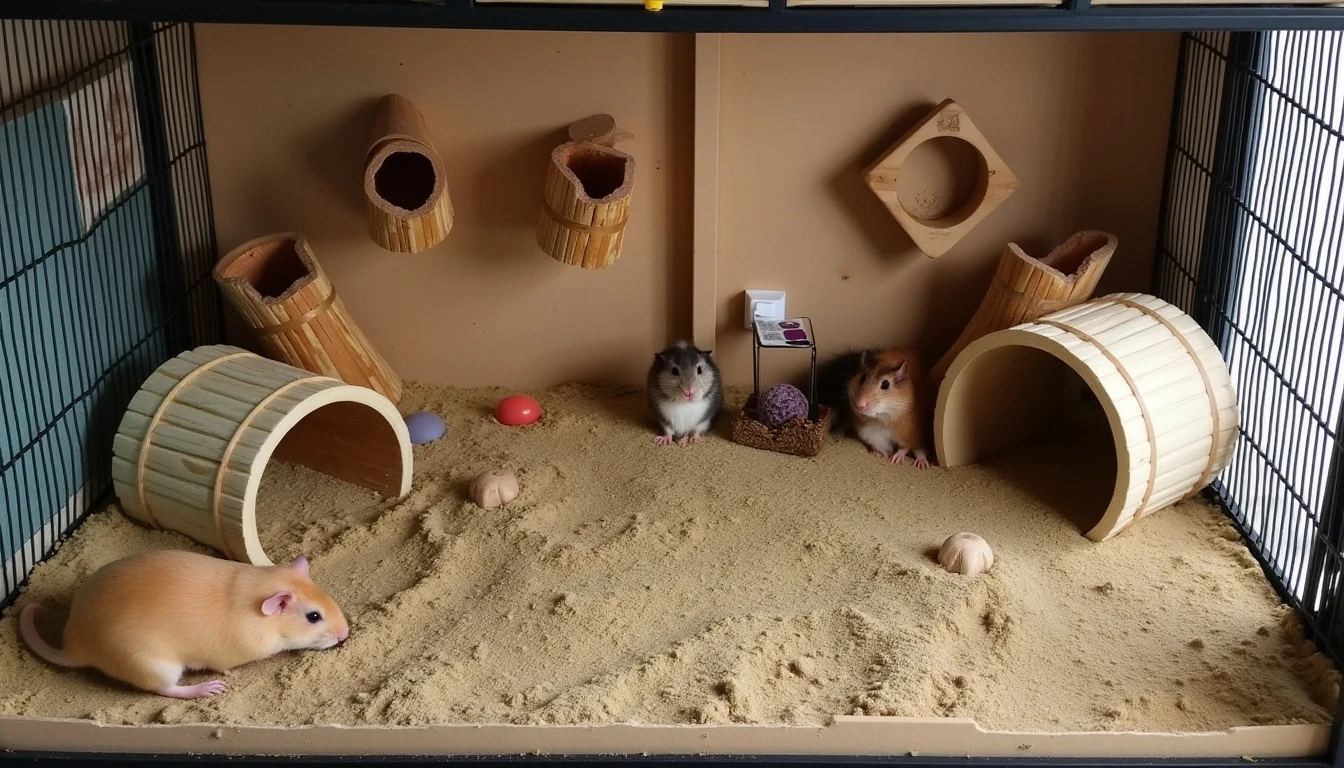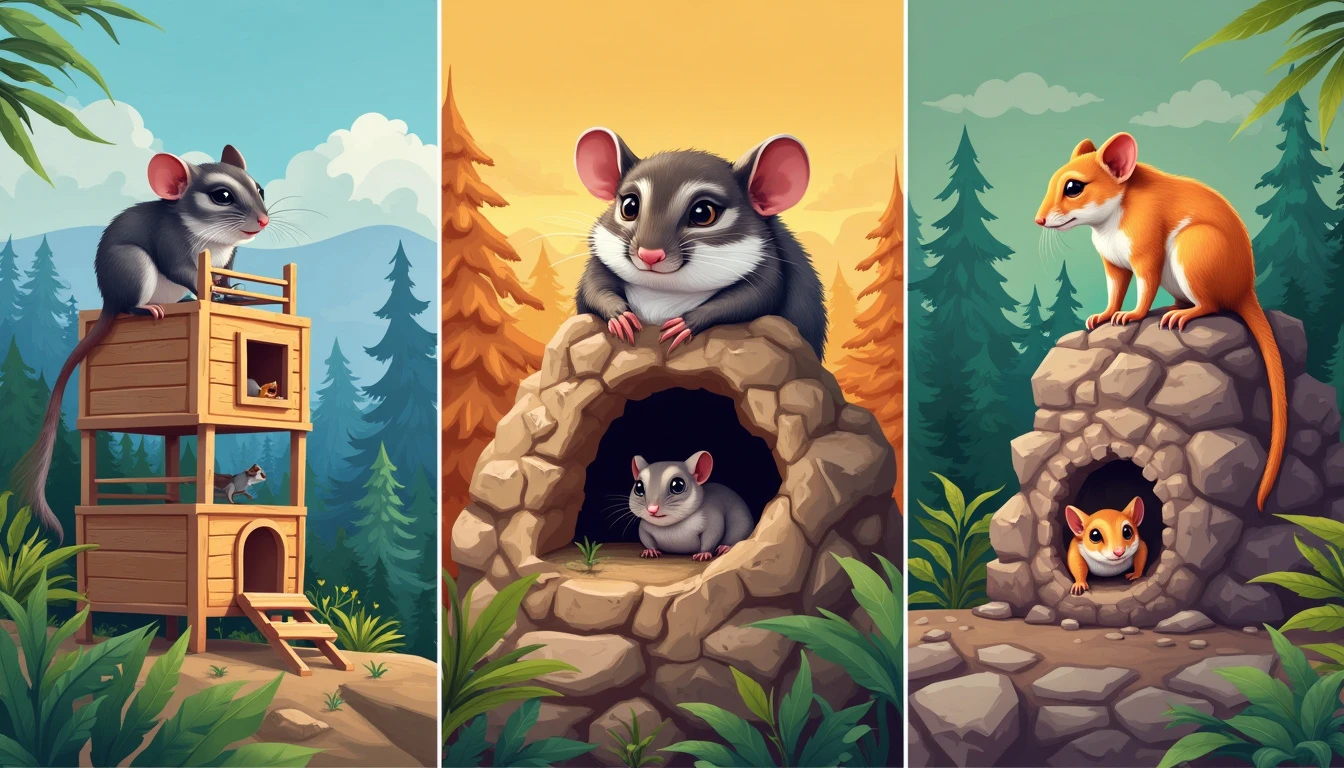Exotic rodents like chinchillas, degus, and sugar gliders are becoming increasingly popular pets. Unlike traditional hamsters or guinea pigs, these animals require more specialized care, particularly when it comes to creating their ideal habitat. Ensuring that their environment mimics their natural habitat is key to maintaining their health, happiness, and longevity. In this blog post, we will explore the best habitats for exotic rodents, delving into specific environmental needs, setup ideas, and expert tips on how to create the perfect home for your furry friend.
Why Exotic Rodent Habitats Matter
When it comes to exotic rodents, housing is not just about providing space. It’s about recreating an environment that meets their physical, mental, and social needs. Each rodent species has distinct requirements, and understanding these will help ensure they thrive in captivity. Inadequate housing can lead to stress, illness, or destructive behaviors, while a well-planned habitat can enhance their well-being.
Key Benefits of Creating Optimal Habitats
- Reduces Stress: Rodents are sensitive animals, and a habitat that mimics their natural environment helps them feel secure.
- Promotes Natural Behaviors: Climbing, burrowing, and foraging are critical behaviors that reduce boredom and improve mental stimulation.
- Boosts Longevity: Animals kept in proper environments live longer, healthier lives.
- Improves Social Interaction: For social species, proper housing encourages healthy interaction, preventing loneliness or aggression.
Understanding the Natural Habitat of Exotic Rodents
Before setting up a habitat, it’s crucial to understand where these animals come from in the wild. Chinchillas, for instance, are native to the Andes mountains, living in cool, rocky terrains where they hide in crevices. Meanwhile, sugar gliders thrive in the tree canopies of Australia, living in groups and gliding between trees.
Below is a breakdown of some popular exotic rodents and their natural habitats:
| Species | Native Habitat | Key Environmental Features |
|---|---|---|
| Chinchilla | Andes Mountains, South America | Cool, dry, rocky terrains |
| Degu | Chile, South America | Scrublands and rocky areas |
| Sugar Glider | Australia, New Guinea | Forest canopies, warm climates |
| African Pygmy Hedgehog | Africa | Dry savannas, burrow-based habitats |
| Prairie Dogs | North America | Grasslands, underground burrows |
By understanding these natural environments, you can begin crafting the best habitats for exotic rodents that will allow them to exhibit their natural behaviors.
Ideal Habitat Setup for Exotic Rodents

Each species has unique needs, but there are several universal considerations when setting up the perfect environment for exotic rodents. Let’s explore each of these factors:
1. Cage Size and Space

The size of your rodent’s habitat is perhaps the most important factor. Many exotic rodents are highly active, and they need adequate space to climb, run, and explore. A cramped environment can cause stress and health issues.
- Chinchillas: A multi-level cage is ideal due to their love for climbing. A minimum cage size of 4×4 feet is recommended.
- Sugar Gliders: These animals need tall enclosures to simulate their natural treetop lifestyle. Look for cages at least 3 feet high.
- Degus: Provide them with a horizontal space since they enjoy running. A cage at least 3×2 feet is recommended for a pair.
Pro Tip: Invest in a habitat with plenty of vertical space for climbing rodents like chinchillas and sugar gliders, but prioritize floor space for burrowing species like degus and prairie dogs.
2. Enrichment and Stimulation
Exotic rodents require mental and physical stimulation to prevent boredom, which can lead to destructive behaviors like chewing cage bars. Enrichment items are essential to mimic their natural foraging and playing behaviors. Some great options include:
- Exercise Wheels: Choose solid wheels (not wire) to protect their feet.
- Foraging Toys: Hiding food in toys encourages their natural hunting instincts.
- Branches and Ropes: Perfect for sugar gliders and chinchillas that love climbing.
- Dust Baths: Essential for chinchillas to keep their coats healthy and clean.
3. Temperature and Humidity Control
Exotic rodents are often sensitive to temperature and humidity levels. Chinchillas, for example, can suffer from heatstroke if the temperature exceeds 75°F, while sugar gliders prefer warmer, humid environments similar to their natural habitat.
| Species | Ideal Temperature Range | Humidity Range |
|---|---|---|
| Chinchilla | 60-70°F | Low (Below 50%) |
| Sugar Glider | 75-85°F | 60-70% |
| Degu | 65-75°F | Low to Moderate |
Tip: Use thermostats and hygrometers to monitor your rodent’s habitat. Keep their cages away from direct sunlight or drafts.
4. Substrate and Bedding
The type of bedding or substrate used in an exotic rodent’s habitat is important for both comfort and hygiene. Avoid cedar and pine shavings, as the oils can be harmful to rodents. Instead, opt for safer alternatives like:
- Aspen shavings: Safe for most species.
- Paper-based bedding: Excellent for burrowing species like degus.
- Fleece liners: Ideal for chinchillas to prevent respiratory issues.
5. Dietary Requirements
Exotic rodents have very specific dietary needs. It’s essential to provide a habitat that accommodates these, with space for multiple feeding stations, water bottles, and areas for treats and snacks.
- Chinchillas: Need hay (like timothy hay) as the base of their diet, plus chinchilla pellets and the occasional treat like dried rose hips.
- Sugar Gliders: Require a varied diet of fresh fruits, vegetables, protein (like cooked chicken), and specialized glider pellets.
- Degus: Primarily herbivores, needing hay, fresh greens, and degu-specific pellets.
Case Study: The Perfect Habitat for a Pair of Chinchillas
To illustrate the importance of a well-designed habitat, let’s consider a case study of a chinchilla owner who successfully built the ideal setup. John, a first-time chinchilla owner, initially housed his pets in a small, single-level cage. After observing signs of stress—such as fur biting and lack of activity—he decided to upgrade their habitat.
John researched and purchased a 4×4 multi-level cage with plenty of shelves for climbing, a large exercise wheel, and multiple hiding spots. He also ensured a consistent cool temperature with the use of air conditioning and added a dust bath twice a week.
Within weeks, John noticed a remarkable improvement. His chinchillas were more active, their fur returned to its lush state, and their destructive behaviors ceased. This underscores how critical the best habitats for exotic rodents are to their overall well-being.
Common Mistakes to Avoid When Creating Exotic Rodent Habitats
Even with the best intentions, many pet owners make mistakes when setting up rodent habitats. Here are some pitfalls to avoid:
- Cramped Spaces: Exotic rodents need plenty of space. Never rely on cages meant for smaller pets like hamsters or mice.
- Improper Bedding: Avoid using pine or cedar shavings as they can cause respiratory issues.
- Inadequate Temperature Control: Ensure you monitor the temperature and humidity consistently, especially with temperature-sensitive species.
- Lack of Enrichment: Rodents that don’t have toys or mental stimulation may develop boredom-related behaviors, like gnawing on bars or self-harm.
Conclusion: Building the Best Habitat for Exotic Rodents
Creating the best habitats for exotic rodents goes far beyond simply buying a cage and filling it with bedding. It involves crafting an environment that mirrors their natural habitats, allows for physical and mental stimulation, and promotes good health. By considering factors like cage size, temperature, substrate, and enrichment, you can ensure your exotic rodent leads a happy and fulfilling life.
Whether you’re housing a curious degu, an agile chinchilla, or a gliding sugar glider, remember that the investment in their environment is an investment in their overall well-being. A well-cared-for rodent is healthier, more active, and will enjoy a longer, more fulfilling life.
Final Tip: Regularly observe your rodent’s behavior and adjust their habitat as needed. What works for one rodent might not work for another, so personalization is key.
